Top 6 Best Non-Clumping Litters on the Market Today
Contents of Article
- What is the Best Non-Clumping Cat Litter?
- Here’s what is great about non-clumping cat litter:
- Types of Non-Clumping Cat Litter
- Choosing the Right Non-Clumping Cat Litter
- Top 5 Best Non-Clumping Cat Litters
- Feline Pine Original Cat Litter Review
- PrettyLitter – 20% OFF w/ code BESTLITTER
- Tidy Cats Breeze Cat Litter Pellets Review
- Tidy Cats Non-Clumping 24/7 Performance Long Lasting Odor Control Cat Litter Review
- Yesterday’s News Original Formula Cat Litter Review
- Blue Buffalo Naturally Fresh Walnut-Based Pellet Non-Clumping Cat Litter Review
Clumping clay cat litter is by far the most popular type of litter sold in the United States and Canada. In most cases, clumping litter’s popularity exists for a good reason. It’s convenient, effective, and cats like using it.
But non-clumping litter is still on the market for a reason. It offers certain qualities that clumping litter doesn’t.
In this article, we’ll start by discovering what non-clumping litter has to offer. Once we’ve done that, we’ll check out the different types of non-clumping litter on the market. There might be more options than you expected. We’ll also think about what qualities make a non-clumping litter great.
Finally, we’ll share our picks for the top 5 best non-clumping litters on the market today.
Let’s go!
What is the Best Non-Clumping Cat Litter?
-
- Feline Pine Original Cat Litter
- PrettyLitter – 20% off w/ code BESTLITTER
- Tidy Cats Breeze Cat Litter Pellets
- Tidy Cats Non-Clumping 24/7 Performance Long Lasting Odor Control Cat Litter
- Yesterday’s News Original Formula Cat Litter
- Blue Buffalo Naturally Fresh Walnut-Based Pellet Non-Clumping Cat Litter
Here’s what is great about non-clumping cat litter:
It’s safer for cats who eat litter.
Kittens under 3-4 months of age are prone to litter ingestion. The properties that make clumping clay litter so effective can make your kitten sick. Wet clumping clay litter can expand up to 18 times its original size. Imagine what it could do in your kitten’s tiny digestive tract.
Rapidly expanding clumping clay litter could create serious gastric disturbance and even intestinal blockage. That’s why it’s recommended that young kittens use non-clumping litter instead.
Click here to find the best safe litter for kittens.
But this issue doesn’t only affect kittens. Cats of any age can end up consuming litter. During grooming, your cat will ingest any dust or granules trapped on their paws or in their fur.
Incidental ingestion isn’t usually something to worry about, but some cats ingest more than others.
Some cats get large amounts of litter stuck to their paws. Others ingest it intentionally. Cats with pica eat cat litter to make up for mineral deficiencies. It’s unlikely that ingesting the occasional grain or two will harm your adult cat, but larger amounts could lead to constipation and other problems.
A non-clumping litter protects your cat from these complications.
It’s usually cheaper.
Generally speaking, non-clumping litter is cheaper than clumping litter.
A non-clumping product might cost 50% less than its clumping counterparts. At the same time, you’ll probably need to refill the litter box more frequently. The cost of replacing the litter so frequently could nullify any initial savings.
If you’re worried about price, track your expenditures over time to determine if your low-cost litter is a good value.
Some cats prefer it.
While cats typically prefer clumping litter, some do have a preference for non-clumping products. Especially if your cat has used non-clumping litter in the past, this type may be a more comfortable choice.
Regardless of what the majority says, it’s always key to remember that your cat is an individual. Your cat may prefer litter that most other cats dislike. What’s most important is finding a cat litter that works for both you and your cat. Once you’ve found something that works, stick with it. Litter box avoidance can be a nightmare with the potential to harm both your home and your cat’s health.
Types of Non-Clumping Cat Litter
There are plenty of different types of non-clumping litter out there.
You’ll find both traditional clay and biodegradable products.
A non-clumping litter may be good at odor control or do a terrible job of neutralizing smells. It could be comfortable on your cat’s paws or deter them from the litter box. Some non-clumping products produce dust and others don’t.
Pellet Cat Litter
Pellet-style litter is made from a variety of materials. These include paper, wood, walnut, soybeans, and even clay. The materials are compressed into relatively uniform absorbent pellets. Because they may come from so many different materials, the absorbency and odor control varies from product to product. One common problem with pellet-style cat litter is comfort. Cats prefer fine, sand-like litter that’s gentle on their paws and easy to dig in. Some cats love their litter pellets, though, so this type of non-clumping litter is worth giving a try.
The most popular types of pellet cat litter are paper and wood, so let’s learn a little bit more about them.
Paper
These pellets are made from recycled paper. They’re gentle on the paws and are often recommended by veterinarians. They’re a good choice for cats with stitches that can’t be contaminated with conventional litter. The pellets are absorbent and essentially dust-free.
They don’t provide great odor control and demand frequent replacement to keep your house smelling good.
Wood
Wood is naturally absorbent and these pellets do a good job of locking in moisture and odor. They have a woodsy smell that many people enjoy.
Non-Clumping Clay Cat Litter
From the 1947 invention of commercial cat litter to 1984, non-clumping clay litter was the household standard.
In the 1980’s, a biochemist named Thomas Nelson first used sodium bentonite clay to create a clumping clay cat litter. This easy-to-scoop upgrade quickly ousted non-clumping litter from its position as the leading cat litter type. It’s reigned supreme ever since.
Non-clumping clay litter is made from absorbent but non-clumping clay. Attapulgite, montmorillonite, sepiolite, and calcium bentonite clay are commonly used.
These clays absorb odors and moisture well until they reach their saturation threshold.
Instead of scooping out urine clumps daily, you’d scoop out solid waste and wait for the litter to become saturated. Once urine saturates the litter, it will start to smell. You’ll need to toss out everything in the box and start fresh.
Crystal Cat Litter
Instead of clumping, this type of litter absorbs extraordinary amounts of moisture without becoming saturated. The daily routine is much like using a non-clumping clay litter. You pick out the solid waste, and let the litter do its job with liquid.
The crystal litter difference is that you’ll also give the litter a daily stir and don’t need to change it for up to 30 days.
But crystal cat litter isn’t perfect. Both large and fine crystals can be uncomfortable on your cat’s sensitive paws. It’s prone to urine pooling and isn’t a good choice for multiple cat homes. It doesn’t have the kind of widespread popularity among cats that a litter should have.
Choosing the Right Non-Clumping Cat Litter
Here are some things to look for in a non-clumping litter.
Low Dust
Pick a non-clumping litter that doesn’t produce a lot of dust.
For cats and humans alike, large amounts of dust can aggravate respiratory issues. Dusty cat litter is also easy to track and tends to make more of a mess than do low-dust litters.
Although clay is dustier than other types of cat litter, the design of certain non-clumping clay litter products promote minimal dust.
Non-clay products like paper and wood pellets produce virtually zero dust. Crystal litter also produces less dust than clay, but that doesn’t mean it’s dust-free.
Minimal Tracking
When your cat goes into the litter box, litter may stick to their paws. When they leave the litter box and that litter is still there, it can get deposited through the house. To keep your floors clean, look for a low-tracking litter.
Generally speaking, fine litter tracks more than litter made with large granules or pellets. This is where a problem arises: cats prefer fine, sand-like litter. You’ll need to balance your interest in minimal tracking with your cat’s preferences.
Good Odor Control
This one is crucial. Effective odor control isn’t only good for you: it’s a key part of keeping your cat happy. Cats have ultra-sensitive noses. When your cat gets fed up with the smell, the situation can turn ugly. Litter box avoidance is a serious problem. Avoid it at all costs.
Particularly when you can’t scoop out urine clumps, it’s critical to find a litter that controls odors. Some litter contains deodorizing agents like activated carbon and baking soda. Others are scented, but cats don’t like perfumes. If using a scented litter, be careful. Choose a lightly scented product and keep a close eye on your cat’s reaction.
Cat Appeal
Again, your cat has to want to use the litter box. If they don’t like the texture of the litter, they could reject it.
While some cats like using pellet litter, many don’t like the paw-feel of walking on large pellets. Crystal litter doesn’t clump, but it’s usually not comfortable for your cat. Clay litter is typically a feline favorite.
Seek out soft, fine, easy-to-dig litter that’s comfortable on your cat’s paws and doesn’t contain any irritating ingredients.
Top 5 Best Non-Clumping Cat Litters
Quick Look : Top 5 Best Non-Clumping Cat Litter
Feline Pine Original Cat Litter Review
Pine pellet litter
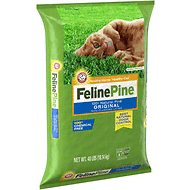
This 100% natural pine litter uses highly absorbent pine fibers to capture and trap moisture and odors. The litter is made from compressed pine sawdust. Instead of clumping, the pellets disintegrate when damp.
Each day, you should scoop out solid waste. Shake the litter to allow the sawdust to drop to the bottom of the box and fresh pellets to take their place on top.
Once the pellets have reverted to sawdust, it’s time to throw out the litter. It’s a long-lasting litter that absorbs well and requires less frequent disposal than many others. The litter should be replaced about once each week.
These pellets have a naturally fresh pine scent that many users love. It isn’t dusty and the pellets are low-tracking. – Buy It
Pros
-
-
- Good odor control
- Has a pleasant natural wood smell
- Minimal tracking and virtually dust free
- No additives or scents that could irritate your cat
- Biodegradable
- Cheaper than most other biodegradable litters
-
Cons
-
-
- Cats may not like the feel of the pellets under their paws
-
PrettyLitter – 20% OFF w/ code BESTLITTER
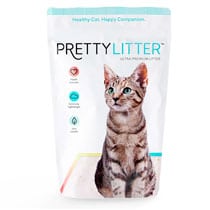
PrettyLitter is unscented, lightweight, and environmentally friendly, and it changes color when it detects a pH change to alert you to your cat’s possible health issues. PrettyLitter detects health issues that can be found through a change in pH such as urinary tract infections, bladder stones, inflammation, kidney issues, and more. With a once-a-month convenient delivery service, PrettyLitter costs less than some other typical cat litters (about $22/cat) and the amount is tailored to suit the number of cats in your home. The absorbent silica gel traps odors and eliminates moisture and is made from natural minerals, which means less dust and allergens and less litter in the landfill. – Buy It
Pros:
- Made from natural minerals
- Silica gel traps odor
- Detects pH change that may indicate medical issues
Cons:
- Non-clumping can cause tracking
Tidy Cats Breeze Cat Litter Pellets Review
Zeolite pellets that pair with a clean, simple litter box system
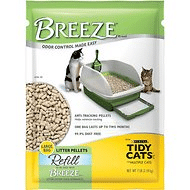
These specially-designed pellets are made with mordenite zeolite, an absorbent mineral often used to make non-clumping clay litter and litter deodorizers.
The pellets work in conjunction with the Breeze Cat Litter System. This system allows urine to pass through the litter. Liquid falls onto the odor-controlling Breeze Cat Pad that sits underneath the litter. Solid waste remains on top for easy removal.
Because you remove solid waste daily and change out the disposable pad as infrequently as once a week, the system is a good choice for people who don’t want to use clumping litter, but also don’t want to deal with a damp, dirty litter box that demands regular changing.
The anti-tracking pellets are 99.9% dust free, helping to keep your home clean and you and your cat breathing easily. They control fecal odors by effectively dehydrating any solid waste. – Buy It
Pros
-
-
- Great odor control
- The Breeze Cat Litter System is clean and easy to maintain
- Non-tracking pellets
- Virtually dust-free
-
Cons
-
-
- Somewhat expensive
- Only compatible with a specific litter box system (not included)
-
Tidy Cats Non-Clumping 24/7 Performance Long Lasting Odor Control Cat Litter Review
Non-clumping clay
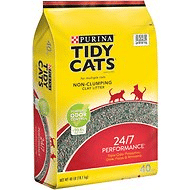
This low-cost classic is a straightforward, simple non-clumping clay litter. It contains an extended-release deodorizing system that helps to neutralize smells for up to one week. Although Tidy Cats doesn’t say that this is a scented litter, many reviewers say that the litter carries a scent. It may not be appropriate for cats with perfume allergies or those who find fragrances irritating.
The granules aren’t the smallest – some reviewers say that they’re too large and heavy. This is good for minimizing tracking, but some cats won’t like the texture. The litter is relatively low-dust. – Buy It
Pros
-
-
- Extended deodorizing formula keeps odors under control
- Low tracking
- Low dust
- An affordable low-cost litter
-
Cons
-
-
- Some reviewers say that this litter has an added scent
-
Yesterday’s News Original Formula Cat Litter Review
Recycled paper pellet litter
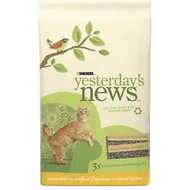
This pellet litter is made from recycled materials. Used newspapers, magazines, and phone books are repurposed into a gentle, absorbent litter. It’s made without any fragrances, making it ideal for sensitive or allergic cats.
The newspaper pellets are 3X more absorbent than clay and are virtually dust-free. It’s often recommended for cats and people who have respiratory problems and need a safe, non-irritating litter.
The pellets are on the large side. Each pellet is about half an inch in length. They won’t pass through the slots of a typical litter scoop, and this can lead to wasted litter. It’s also not the best litter for odor control. – Buy It
Pros
-
-
- Moderate odor control
- Highly absorbent
- Biodegradable and eco-friendly
- Gentle on your cat’s paws
- Dust-free
-
Cons
-
-
- Doesn’t offer the best odor control
- May be difficult to scoop
-
Blue Buffalo Naturally Fresh Walnut-Based Pellet Non-Clumping Cat Litter Review
Walnut pellet litter
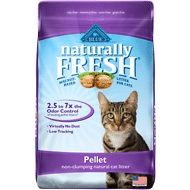
This non-clumping formula is made from the fibrous materials found in walnut shells. According to Blue Buffalo, these walnut pellets control up to 7X more ammonia-causing odors than leading non-clumping litters. The company says that it neutralizes odor better than clay, pine, and wheat litter. Its excellent odor control ability makes it a good pick for multiple cat households.
The litter produces virtually zero dust and the pellets don’t track, helping you to keep your house clean.
Despite these impressive claims about the absorbency and odor control provided by this litter, customer reviews are mixed. Some echo the company’s marketing and rave about the litter’s longevity, ability to control odors, and its excellent absorbency.
Others aren’t so impressed. The most common complaint is that the pellets never dry out and instead become mushy in the litter box. Others dislike the size of the pellets, which are about an inch long and may be too large for some cats. The walnut litter has a dark color that can make it difficult to differentiate between clean and dirty litter. – Buy It
Pros
-
-
- Good odor control
- 100% biodegradable walnut litter
- Unscented and safe for your cat
- Virtually no dust
- Pellets are low-tracking
-
Cons
-
- Litter tends to stay wet
- It’s difficult to differentiate between clean and dirty litter
- Cats may not like the texture of the pellets

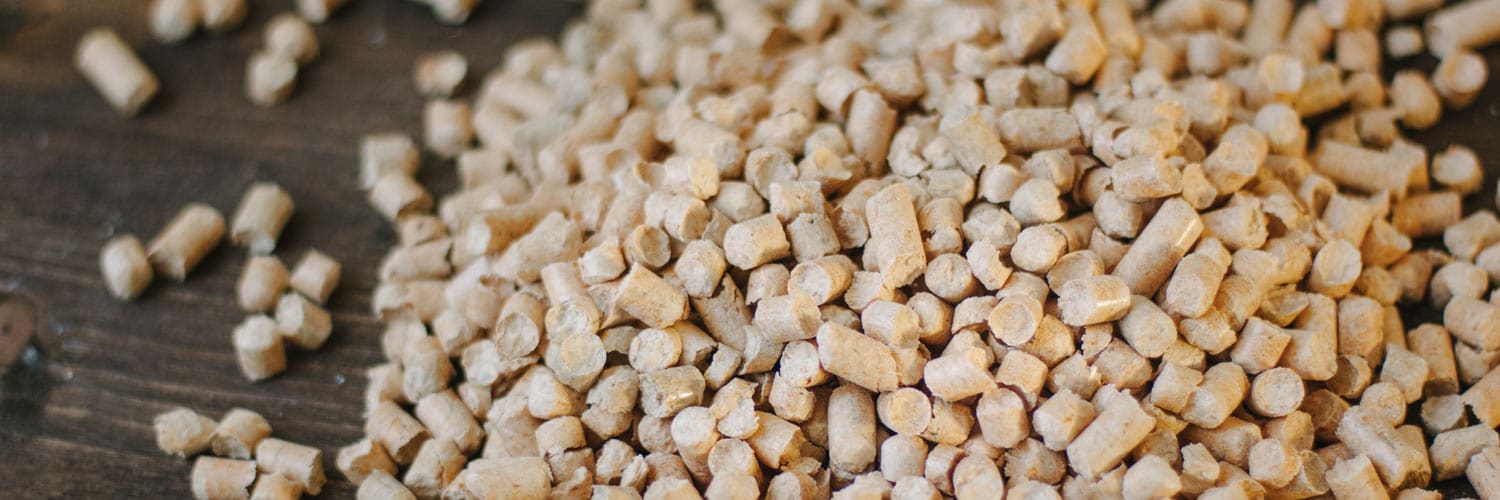




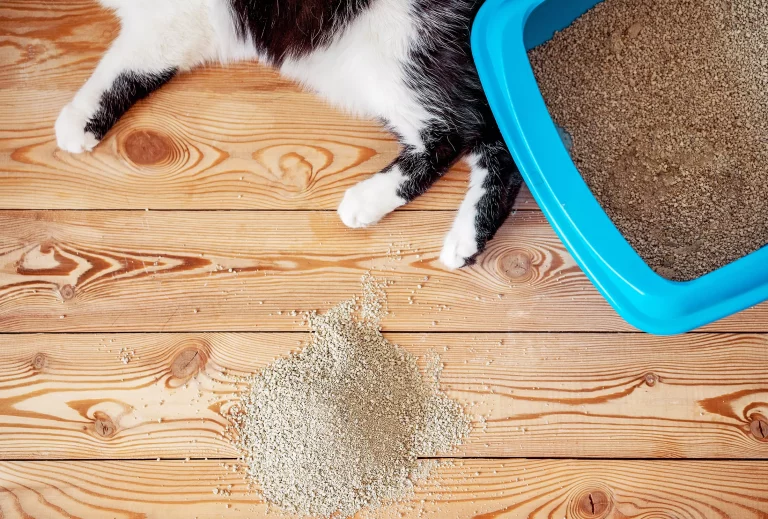
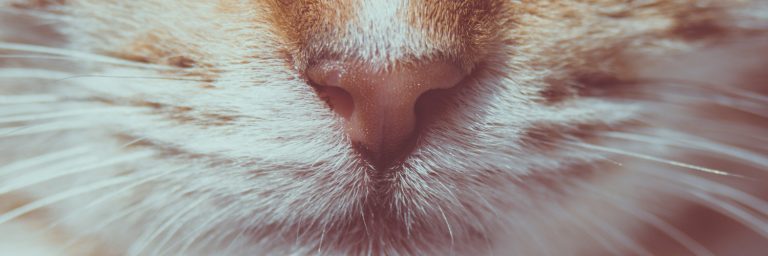
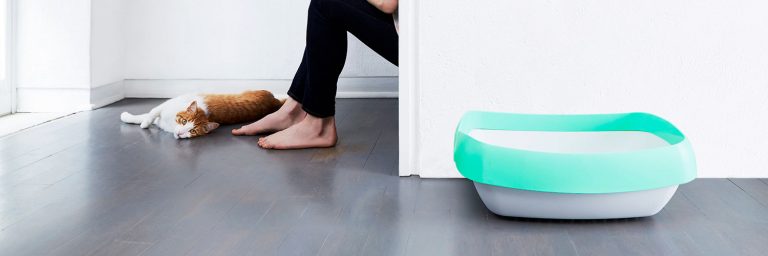
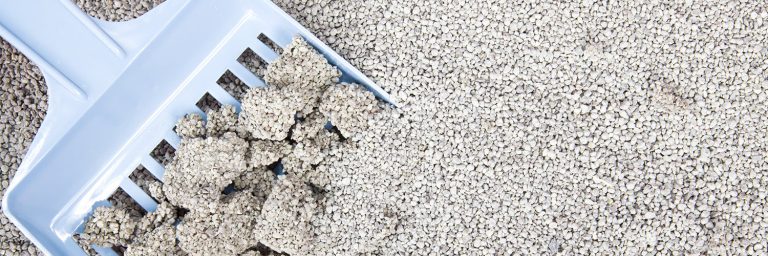
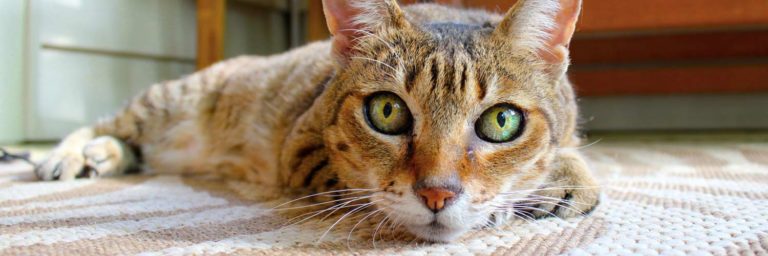
Dear Mallory, Cat parents should be aware that some cats eat the Purina Tidy Cats Breeze Pellets and it can be fatal or extremely expensive to treat. A pet parent on Nextdoor.com alerted me to this with the x-rays showing the blockage. He also gave a link to a site where people post about the issue. I know from experience that lots of cats eat things they shouldn’t. Sadly, “curiosity killed the cat” can be a true statement.
..